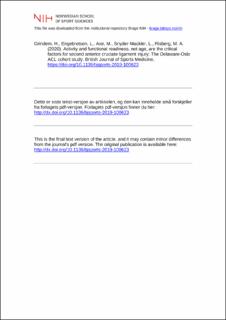| dc.contributor.author | Grindem, Hege | |
| dc.contributor.author | Engebretsen, Lars | |
| dc.contributor.author | Axe, Michael | |
| dc.contributor.author | Snyder-Mackler, Lynn | |
| dc.contributor.author | Risberg, May Arna | |
| dc.date.accessioned | 2020-07-10T06:20:50Z | |
| dc.date.available | 2020-07-10T06:20:50Z | |
| dc.date.created | 2020-06-03T12:44:14Z | |
| dc.date.issued | 2020 | |
| dc.identifier.citation | British Journal of Sports Medicine. 2020. | en_US |
| dc.identifier.issn | 0306-3674 | |
| dc.identifier.uri | https://hdl.handle.net/11250/2663630 | |
| dc.description | Dette er siste tekst-versjon av artikkelen, og den kan inneholde små forskjeller fra forlagets pdf-versjon. Forlagets pdf-versjon finner du på bjsm.bmj.com / This is the final text version of the article, and it may contain minor differences from the journal's pdf version. The original publication is available at bjsm.bmj.com. | en_US |
| dc.description.abstract | Objective: To elucidate the relationships between age, return to level I sport (RTS) within the first postoperative year, passing RTS criteria and second anterior cruciate ligament (ACL) injury. Methods: In a prospective cohort study, 213 athletes were followed for 2 years after ACL reconstruction to record second ACL injuries. Independent variables were age, passing RTS criteria and level I RTS within the first postoperative year (vs later or no RTS). We defined passing RTS criteria as ≥90 on the Knee Outcome Survey — Activities of Daily Living Scale, global rating scale of function and quadriceps strength/hop test symmetry. Results: The follow-up rate was >87% for all outcomes. In multivariable analysis, level I RTS within the first postoperative year and passing RTS criteria were highly associated with second ACL injury (level I RTS HR: 6.0 (95% CI: 1.6 to 22.6), pass RTS criteria HR: 0.08 (95% CI: 0.01 to 0.6)), while age was not (age HR: 0.96 (95% CI: 0.89 to 1.04)). Athletes <25 years had higher level I RTS rates in the first postoperative year (60.4%) than older athletes (28.0%). Of those who returned to level I sport in the first postoperative year, 38.1% of younger and 59.1% of older athletes passed RTS criteria. Conclusion: High rates of second ACL injury in young athletes may be driven by a mismatch between RTS rates and functional readiness to RTS. Passing RTS criteria was independently associated with a lower second ACL rate. Allowing more time prior to RTS, and improving rehabilitation and RTS support, may reduce second ACL injury rates in young athletes with ACL reconstruction. | en_US |
| dc.language.iso | eng | en_US |
| dc.subject | anterior cruciate ligament | en_US |
| dc.subject | anterior cruciate ligament reconstruction | en_US |
| dc.subject | knee function | en_US |
| dc.subject | knee injury | en_US |
| dc.subject | return to sport | en_US |
| dc.title | Activity and functional readiness, not age, are the critical factors for second anterior cruciate ligament injury : the Delaware-Oslo ACL cohort study | en_US |
| dc.type | Peer reviewed | en_US |
| dc.type | Journal article | en_US |
| dc.description.version | acceptedVersion | en_US |
| dc.source.pagenumber | 5 | en_US |
| dc.source.journal | British Journal of Sports Medicine | en_US |
| dc.identifier.doi | 10.1136/bjsports-2019-100623 | |
| dc.identifier.cristin | 1813634 | |
| dc.description.localcode | Institutt for idrettsmedisinske fag / Department of Sports Medicine | en_US |
| cristin.ispublished | true | |
| cristin.fulltext | postprint | |
| cristin.qualitycode | 2 | |
